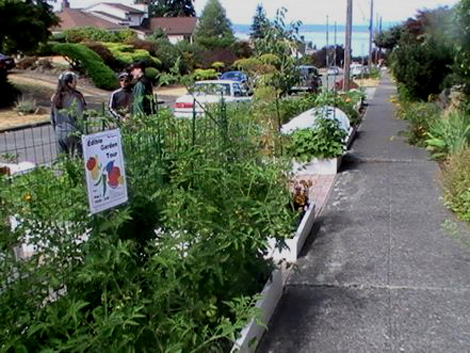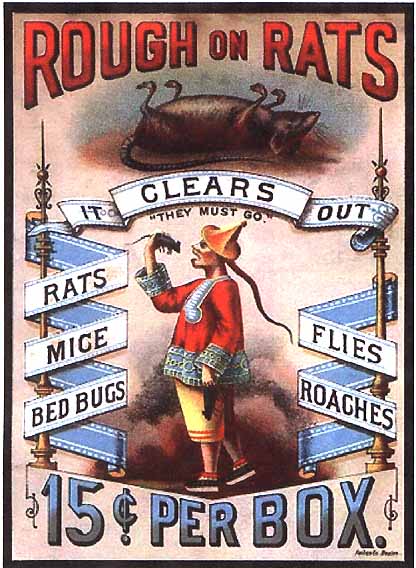(I know this one will get me into trouble…but hey, if I don’t tick someone off I’m not doing my job.)
I have mixed feelings about the increased popularity of urban farming. On one hand, I love the idea that people are becoming more involved in producing their own food. But on the other hand, the naivety of many urban farmers is scary – because they assume that home-grown food is safer and/or healthier than what they can buy at the market.

I give a lot of seminars every year, on a lot of different topics. At the end I usually have a room full of happy people, asking lots of questions and eager to go apply the new knowledge that they’ve gained. But one talk I’ve done has exactly the opposite effect. It’s the seminar I give on vegetable gardens and heavy metal contamination of urban soils. The audiences are subdued and worried. It doesn’t make me feel very good, but on the other hand I know I’ve got people thinking.

Heavy metal contamination of soils is insidious. Like the iocane powder in The Princess Bride, these compounds can be odorless and tasteless…and deadly. Lead, arsenic, cadmium, and a handful of other heavy metals are the legacy of centuries of “civilized” living. Mining, smelting, manufacturing, and driving all contribute to localized toxic hot spots. Unlike organic contaminants, heavy metals are elemental. They don’t break down and go away. The lead from gasoline fumes of the past is still found along roadsides; the arsenic from early pesticides still lingers in soil used for field and orchard crops. Many plants not only take up heavy metals, but accumulate them in their tissues.

It’s easy to avoid heavy metal problems: soil tests are the logical first step. If soils are contaminated, you can build raised beds or use containers with clean, imported topsoil or other growing media for vegetable gardens. Likewise, you might want to take care in buying produce from farmer’s markets – ask questions about possible soil contamination.
So by all means, grow your own vegetables – save money and take satisfaction in producing your own food. But be careful out there.
A bit jumbled, but palt names are still there for vegetables.
Botanical name
Common Name Metal Process
Allium fistulosum
Onion Lead Hyperaccumulation
Allium schoernoprasum
Chives Cadmium Hyperaccumulation
Atriplex hortensis
Garden orach (PCBs) Metabolism
Brassica juncea
Indian mustard Metals Hyperaccumulation
Including: lead, cadmium, & uranium
Brassica oleracea Lead Hyperaccumulation
Kale, collards, broccoli, cabbage, Brussel sprouts, cauliflower, B. ‘Romanesco’
Brassica rapa
Field mustard Cadmium Hyperaccumulation
& Zinc
Claytonia perfoliata
Miner’s lettuce (edible “weed”) Cadmium Uptake/Accumulation
Helianthus annus
Sunflower See Indian mustard Hyperaccumulation
Viola spp.
Violets metals & cadmium Hyperaccumulation
Good Post! My very urban yard in Berkeley’s mixed-use-industrial district was used by a boat machine shop before we moved in… the yard was a mess of greasy motor parts and mystery solvent cans… Needless to say he soil test was a bit scary, though the lead levels were only average for this area with a century old house. My vegetable garden is in galvanized horse troughs filled with organic potting soil and my supposed dwarf lime tree, that quickly out grew it’s pot, is in a raised bed filled with fresh soil and has bamboo rhizome barrier to isolate the below grade soil from the new soil and tree roots. Interestingly a couple of years of growing sunflowers in the worst spots (and sending the stalks and roots to the dump rather than green-waste), the soil tested out with much lower in heavy metals and the sunflowers ate up the volatile organics to nonexistent…
I live in an old house on former farmland in a DC suburb–and near some busy roads, so I have certainly given this some thought. I garden in my back yard only in raised beds of mostly purchased soil (because of the clay), but I also figure it helps in this regard. However, this also hints at the assumption that our farmland is any less polluted. I’ve never heard anyone say home grown is better or safer, but it can be cheaper! And the value of growing your own is the most important thing–and it requires education and common sense.
More info: Tobacco (I doubt you’ll eat some!), corn, sunflower, spinach, and rye have been studied and are capable of removing lead from water, with sunflower having the greatest ability. In one study, after only one hour of treatment, sunflowers reduced lead concentrations significantly. Indian mustard removed a wide concentration range of lead (4 mg/ Liter-500 mg/Liter)
(#__ ) [22, 28]. 22. Raskin, I. And B. D. Ensley. 2000. Phytoremediation of Toxic Metals: Using Plants to Clean Up the Environment. John Wiley & Sons, Inc., New York.
Although I don’t have any land to plant in, this post certainly has me thinking about how my container plants might be affected by pollution from automobile exhaust. Is this something to worry about? I am growing my own leafy greens on my apartment’s balconies on a street just off the main drag of the downtown core.
Just another tip: If you live in a house that pre-dates 1976 and you’re planting veggies in borders next to the house, check for lead levels. House paints prior to 1976 contained high levels of lead, and paint jobs after that time, if not done properly, could loosen paint flakes and dust, dropping them into the soil around he house. Speaking of soil around houses, many modern homes are built on fill dirt, which may come from unknown sources. You’re probably going to enrich that soil anyway with amendments because the fill soil is crappy to grow anything in, but still it’s wise to think about.
Just today I was perusing Etsy, researching herbal products and wondered about some of these points.
The marketing copy always makes you feel like the produce is grown in the most pristine of conditions. Even at the farmer’s market I wonder why one stand’s strawberries taste so much better and are less expensive than an adjacent booth. I need to buck up and ask growers how they grow and what they use to fertilize and enhance quality.
There are also a lot of processed products online and in farmer’s markets based on home grown herbs and other crop. These tasty treats, herbal concoctions, and beauty products are many times prepared in home kitchens.
I am going through all the licenses and requirements to make products from my home grown garden. I’m finding I need to use a certified kitchen to process tea out of dried leaves. Logistically this will be a pain, but maybe for the better.
I have raised beds and filled them with “clean” fill dirt plus added a truck load of compost from an “organic” friend. But now I’m wondering about the fill dirt.
This is important information making me think way behond gas emissions. I’ve got tons of research to do and a big thanks to those that publish content and comments that inform the public and wannabe urban gardeners like me.
What lab do you use for heavy metal testing? Amherst does lead, but I don’t know that they check cadmium, arsenic etc. Suggestions?
Robin, many counties will offer testing for specific heavy metals that are known local contaminants; for instance, Pierce County in Washington state will test soils for arsenic since we had smelter deposition of this metals for years. Check there first. You can also contact U Mass Amherst directly to see if they offer testing for other heavy metals.
Has there been any research testing the amount of heavy metals that end up in vegetables grown in contaminated soil, besides the above mentioned ones about species that remove them?
I want that rat poison poster. Way cool!
Alan, yes, there is a great deal of literature on specific plants and their uptake of specific heavy metals. Hundreds of papers. But generalities are impossible to make, because there are so many different variables that influence uptake.
I don’t think anyone would really be in an uproar over double checking your soil before planting, you’re not telling them not to plant at all. I do feel a bit dumb for not thinking of that actually. I turned over my soil, went all bananas of the massive amounts of worms and started planting! It would also be good to know what’s in that leaf compost that my county sucks up in the fall and returns to us in the spring so I will test both.
I ran into this some years ago while setting up a community garden on what had been old farmland. There were several lead hot spots, with our thinking being that lead arsenate (used in orchards) was the potential cause. Living in a semi- rural community, where many houses have old barns/were old farm land I always caution to soil test!
Great info. Lucky me I recently found your website by
chance (stumbleupon). I have book marked it for later!